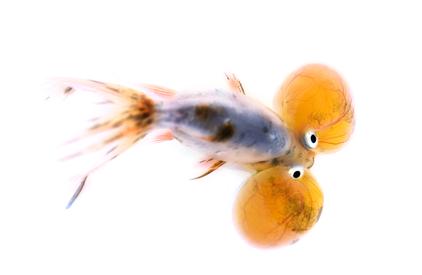| Back to Back Issues Page |
 |
|
The Goldfish Gazette, Issue #039 -- Fancy Variety Care March 31, 2017 |
Goldfish Care Tips and GuidelinesA Free Monthly Resource For Goldfish Enthusiasts In This Issue
Goldfish aren’t normally aggressive to one another, but at feeding time it is the biggest and fastest that get the most food. In a mixed community aquarium, some varieties of fancy Goldfish will slowly starve to death. Care of Fancy Varieties
If you have an aquarium of mixed Goldfish varieties, have you noticed some seem to be fat, active and growing, and others don’t seem to be thriving? I’ll bet those that aren’t thriving are the more developed varieties; perhaps a Moor or Water Bubble Eye, or a fish with very developed fins. Often these fish develop swim bladder problems or other diseases due to underfeeding. Don’t Underfeed Your GoldfishOne of the first rules Goldfish keepers are taught is, don’t overfeed your fish. We know that you can’t over feed Goldfish, only pollute their water, but many Goldfish keepers feed only enough that can be eaten in two minutes as many websites suggest.In the Goldfish world, the fastest and largest fish feed first, the smallest and slowest come last. Goldfish GroupsGoldfish are categorized into 3 broad groups based on their degree of development:
Single Tail VarietiesSingle tailed varieties don’t seem to be hindered much by having longer fins than the Common Goldfish. I include the Comet and Bristol Shubunkins in this group. I don’t include fish that have a single tail fin when they should have two. A single tailed Moor will be quicker than a twin tailed Moor, but it still has the same short sighted vision.Twin Tail Normal Eyed VarietiesTwin tailed varieties normally have deeper bodies. Some varieties such as the Pearl Scale can take this to the extreme with bodies so deep they resembling golf balls which makes swimming fast impossible.A Veiltail will never move as quickly as a short tailed fantail or Japanese Wakin, (a twin tailed variety with short fins and a streamlined body). Although classed as normal eyed, Lionheads, Ranchu and Orandas can have their sight limited by their wens or head growth. In extreme examples both eyes can be completely covered. Abnormal Eyed VarietiesAbnormal eyed varieties include Moors, Celestials and Water Bubble Eyes. These are the most disadvantaged in a mixed variety aquarium because of their impaired vision. Moors are the most skilled of this group finding and catching food. Celestials can only see food above, and must locate food on the bottom by smell.Water bubble Eyes are the most disadvantaged of all the varieties. They seem to have depth perception problems and often miss food dropping down in front of them. Because their eyes are squeezed upwards by the pressure of the water sacs, they have similar food locating problems as Celestials. The size of their water sacs also affects how fast they can swim. Those with very large sacs often avoid swimming and sit on the bottom for long periods. Feeding problems can also be caused in any variety by mouth defects. Often the smallest fish in a brood will have a defect that reduces the size of the mouth opening. Mixed Variety FeedingIdeally each Goldfish variety should only be kept with their own kind.Always closely observe your fish feeding and identify any that don’t appear to be able to compete for food. If you find you do have fish that are becoming underfed, a couple of options to try could be using an acrylic panel to temporarily divide off the aquarium during feeding, or using a gel food that can be smeared on to a flat surface and placed in the same position in the aquarium at feeding time. Suspending green food such as kale in the aquarium also gives the slower fish more opportunity to get their share as it doesn't quickly dissolve or drop into hard to reach crevices.
Comments? Ideas? Feedback? I'd love to hear from you. Just reply to this e-zine and tell me what you think, or what topics you want covered. Next Month's Topic Does Line Breeding Weaken The Strain?www.facebook.com/aboutgoldfish |
| Back to Back Issues Page |